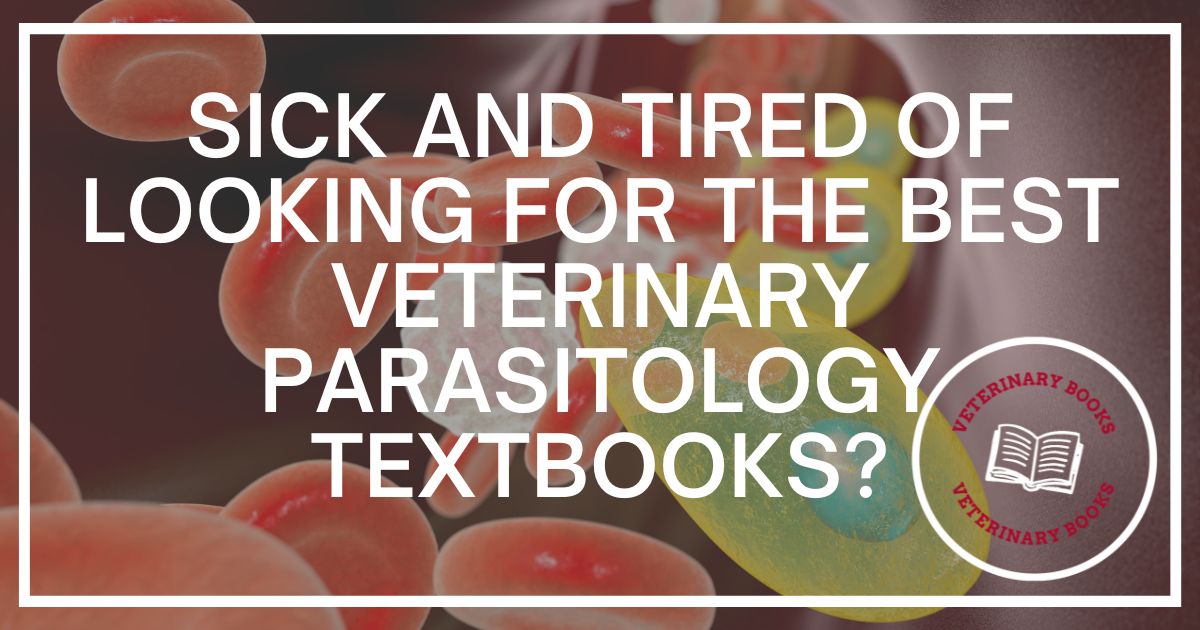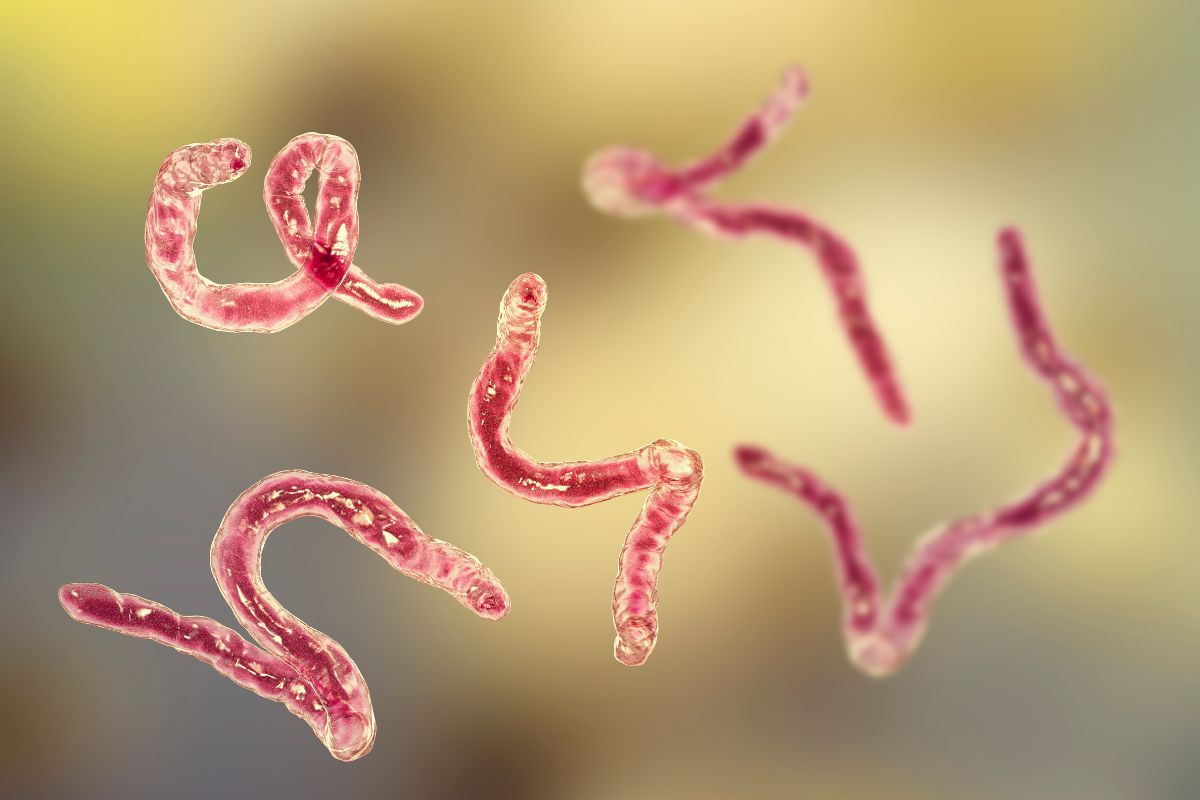Looking for the best veterinary parasitology textbooks might be tiring and extremely time-consuming, especially if you’re a student and you’ve got piles of books on your to-find and to-buy lists! You probably still need to update your library even if you’re part of the American Association of Veterinary Parasitologists! That’s why we’re here!
We’ve selected the 11 best textbooks on veterinary parasitology that will greatly help you in your journey as a veterinarian or toward becoming one! To address a wider audience, we’ve chosen books of certain types.
Some focus on the most common parasites, others on specific parasites or animal host species. At the same time, some discuss parasite isolation and how laboratory parasite reproduction may help diagnose, treat, prevent, and control infections.
Wait no more! Continue reading to find the best veterinary parasitology book you’ll read this year!
What is Veterinary Parasitology?
Veterinary parasitology is a field that studies parasites of both wild and domestic animals. Moreover, it explores the relationship between the animal host and the parasite, the origin and the evolution of the parasite, its morphology, life cycle, and needs.
Once veterinary parasitologists outline these details, they can treat the animal and help prevent parasitoses. Their research can also help and improve eventual animal breeding.
What Do Veterinary Parasitologists Do?
If you’re planning to become a veterinary parasitologist, you’re probably trying to find some pros and cons of working in the field.
Just as the job title implies, veterinary parasitologists diagnose pets with and treat them for parasites. These animal doctors learn to detect parasites in fecal or blood samples. Then, once they detect the parasite type, they devise a treatment, prevention, and control plan.
If you decide to become a veterinary parasitologist, you’ll work with both companion animals and farm livestock.
If you want to extend your scientific field, you can study wildlife parasitology, too. This way, you’ll be able to help other animals in need. For example, you can work in the aquaculture industry to minimize the parasites’ negative impact on fish.
To become a veterinary parasitologist, you’ll need a Bachelor’s Degree in one of the following fields: microbiology, pathology, or immunology.
A Master’s Degree will help further consolidate the acquired knowledge. Moreover, you can choose a specific field for your Master’s, such as parasitic or zoonotic diseases.
If you want to boost your career further, you can opt for a Ph. D. in Parasitology, which means you’ll have to conduct a study on a topic of your preference, as long as it’s in the parasitology field.
Who is the Father of Veterinary Parasitology?
Many official sources state that Francesco Redi, an Italian physician, biologist, and naturalist, is the “father of modern parasitology,” as he described over 180 parasite species in his works! Before his discoveries, people thought that parasites appeared spontaneously. However, Redi wrote that parasites develop from the eggs they produce.
Francesco Redi was the first scientist who described ectoparasites. His book Esperienze intorno alla generazione degl’insetti contains his famous illustrations and the first depiction of the Cephenemyiinae tribe of large flies parasitic on deer. Moreover, Redi has also outlined a clear distinction between the earthworm, also called helminth, and the human roundworm.
Must-Have Textbooks on Veterinary Parasitology
Whether you’re planning to become a veterinary parasitologist or you already are one, we’ve prepared a list of must-have textbooks on veterinary parasitology.
We’ve selected general veterinary parasitology textbooks, books focusing on diagnostic parasitology for veterinary technicians, and editions containing veterinary parasite identification charts.
Some textbooks focus on specific animals – for example, we’ve got an edition specifically about fish parasites, one about cattle and sheep parasites, and one about dog parasites, among others.
Most of them are primarily for veterinarians, veterinary students, and researchers. Still, if you’re interested in the field and have read other books on the topic, you may also find them useful!
Check them out and choose whichever you find best!










Diagnostic Parasitology for Veterinary Technicians
General Description
The “Diagnostic Parasitology for Veterinary Technicians” mentions Charles M. Hendrix and Ed Robinson as its authors. This textbook’s sixth edition features more than 300 color photos to help you distinguish between parasites! The authors divided the information into 18 chapters based on the parasite group.
Further on, the authors have organized the chapters depending on the host species, which include cats, dogs, horses, swine, ruminants, lab animals, fish, reptiles, and birds. Some parasites you’ll find information about include nematodes, trematodes, arthropods, and protozoans, altogether with their morphology, life cycles, and other details.
The authors have also included some case studies that will help you understand what information you’ve assimilated and what requires further research. The book consists of a “Technician’s Note,” which the authors have addressed to veterinary technicians.
Compared to other editions, the sixth one provides information on heartworm and hookworm resistance and a “How to Talk to Clients” section.
You’ll find an appendix called “Parasite Reference List by Species and Parasite Type” at the end of the book, as well as a glossary. These two make the whole reading experience much easier!
Available formats: Kindle, Spiral-bound
Target audience: Veterinary technicians
Book edition: Sixth edition
Parasite coverage: Nematodes, arthropods, and protozoans, among others
Animal host coverage: Cats, dogs, horses, swine, ruminants, lab animals, fish, reptiles, birds
Evolutionary Parasitology: The Integrated Study of Infections, Immunology, Ecology, and Genetics
General Description
The “Evolutionary Parasitology: The Integrated Study of Infections, Immunology, Ecology, and Genetics” by Paul Schmid-Hempel is the perfect textbook for veterinary students, researchers, and technicians. It covers the host-parasite relationship and interaction and how the two adapt to one another.
The author discusses topics such as immunology, sexual selection, genetics, evolution, co-evolution, and population dynamics, among others. Besides veterinary parasitologists, other specialists will also find the book useful, primarily students or professionals in fields like virology, conservation biology, and public health.
The book consists of 14 chapters focusing structured depending on the topic, among which are
- Parasite-Human Relationship
- Evolutionary Parasitology
- Parasite’s History And Diversity
- Immunology
- Sexual Selection
- Infection And Pathogenesis
- Host-Parasite Genetics
- Epidemiology
- Host-Parasite Evolution
- Ecology
The end of the book features a glossary, a list of immunological acronyms, references, and an index.
Paul Schmid-Hempel, the book’s author, works at the Institute of Integrative Biology and Genetic Diversity Centre at ETH Zürich University in Switzerland. He has significant work experience thanks to the field and laboratory work, experimentation, and research he has conducted over the years.
Available formats: Kindle, Hardcover, Paperback
Book topic coverage: Host-parasite relationship and interaction, parasite significance, evolution, and history, immunology, sexual selection, and genetics, among others
Target audience: Veterinary students, veterinary technicians, students or professionals in related fields, such as virology and public health
Book edition: Second edition
Toxoplasmosis of Animals and Humans
General Description
J. P. Dubey, the author of the third “Toxoplasmosis of Animals and Humans” edition, is one of the few authors who’ve published anything on toxoplasmosis of animals and humans. He has more than fifty years of experience in working with and observing all types of protozoan hosts.
The third edition of this book provides essential up-to-date information on Toxoplasma gondii, one of the most common parasites in both humans and wild and domestic animals.
The author has structured the book into 27 chapters equipped with numerous illustrations that help assimilate the information.
The book starts with introductory details about Toxoplasma gondii and focuses on its history, general biology, evolution, and transmission. Chapter two discusses toxoplasmosis in humans, while the rest of the chapters address toxoplasmosis in numerous animal species, both domestic and wild.
These animals are:
- Cats
- Dogs
- Pigs
- Sheep
- Goats
- Cattle
- Water buffaloes
- Equids
- Camels
- South American camelids
- Chickens
- Other avian species besides chickens
- Non-human primates
- Australasian Marsupials
- Marine mammals
- Deer and other cervids
- Yak, bison, and other wild ruminants
- Bears
- Wild canids
- Rodents
- Rabbits and hares
- Bats
- Miscellaneous animals
You’ll learn everything about this parasite’s host types, as well as about its history and biology. If you’re a graduate student, a veterinarian, or a researcher, you’ll definitely appreciate having this book on your shelves!
Available formats: Hardcover
Book topic coverage: Toxoplasmosis
Target audience: Graduate students, veterinarians, researchers
Book edition: Third edition
Parasite coverage: Toxoplasma gondii
Animal coverage: All animals and humans prone to getting the Toxoplasma gondii parasite
Parasitology in Veterinary Medicine
General Description
The authors of the “Parasitology in Veterinary Medicine” present an English version of the German edition called “Lehrbuch der Parasitologie für die Tiermedizin.” It primarily discusses common European diseases but addresses parasitic diseases from other parts of the world.
The book provides information organized by parasite groups and animal hosts, summaries, veterinary parasite charts and tables, and a glossary.
The main part of the book will tell you everything about the discussed parasites: biology, immunology, pathogenesis, symptoms, diagnosis, treatment, and prevention.
Another part focuses on the animal hosts, primarily sheep, goats, cattle, pigs, dogs, cats, rabbits, horses, poultry, and bees.
Moving on, you’ll learn about parasites in food, zoonoses, and the key elements in the treatment of and prevention of parasites.
The authors have also included lists of antiparasitic drugs suitable for each type of parasite.
Available formats: Paperback
Target audience: Basic and advanced veterinary students; veterinarians
Book edition: First edition
Parasite coverage: Protozoa, arthropods, helminths, and others
Animal coverage: Sheep, goats, cattle, pigs, dogs, cats, rabbits, horses, poultry, bees
General Description
This excellent book, edited by Ariadna Sitjà-Bobadilla, James. E. Bron, Geert Wiegertjes, and M. Carla Piazzon is the one and only textbook every person interested in the fish-parasite field should own! If you’re researching the topic, you should definitely get “Fish Parasites: A Handbook of Protocols for their Isolation, Culture, and Transmission”!
The editors divided the book into 26 chapters, each discussing a different type of parasite. These include
- Cryptocaryon Irritans
- Philasterides Dicentrarchi
- Trypanosoma
- Loma Salmonae
- Enteromyxum Leei
- Sphaerospora Molnari
- Ligula Intestinalis
The chapters include images and figures, descriptive tables, glossaries, and sources of information that address the parasite’s history, life cycle, culture, and transmission.
While other veterinary parasitology textbooks provide treatment and prevention methods, this book also offers methods for isolating the parasites and eventually reproducing laboratory parasitic infections. The aim is to facilitate parasitic research to understand the diseases they cause and, consequently, prevent and control them.
Available formats: Kindle, Hardcover; new and used versions
Book topic coverage: Fish parasites isolation, culture, transmission
Target audience: Aquaculture researchers and students
Animal coverage: Fish
Veterinary Clinical Parasitology
General Description
The ninth “Veterinary Clinical Parasitology” edition is an up-to-date textbook on internal and external parasites of domestic and laboratory animals. Here’s what this book provides you with:
- Details and illustrated facts about each parasite’s life cycle, distribution, and significance
- Immunodiagnostic and molecular diagnostic tests details
- Parasite-specific material in terms of test methods benefits and limitations
- Fecal examination for diagnosing parasitism
- Blood examination for diagnosing parasitism
- Arthropod parasite detection
- Information about antiprotozoals, anthelmintics, and other antiparasitic drugs.
The parts that discuss parasitism diagnosis through fecal and blood examinations, as well as arthropod parasite diagnosis, contain information confirmed by leading experts in the field!
Needless to say, it is the perfect choice for veterinarians, researchers, and veterinary students. Moreover, since it comes in a spiral-bound format, it’s effortless to use!
Available formats: Kindle, Spiral-bound; new and used form
Book topic coverage: Parasite examination, diagnosis, and treatment
Target audience: Veterinarians, researchers, students
Book edition: Ninth edition
Parasite coverage: Arthropod parasites, fish parasites, as well as protozoan and helminth parasites
Animal coverage: Dogs, cats, ruminants, camelids, horses, swine, birds, rodents, rabbits, reptiles
Dog Parasites Endangering Human Health (Parasitology Research Monographs Book 13)
General Description
Since dogs are probably the most popular pet animals worldwide and carry various parasites, “Dog Parasites Endangering Human Health (Parasitology Research Monographs Book 13)” is a must-have for any veterinarian and veterinary student!
Correct diagnosis, treatment, and prevention of parasitic infections in dogs can significantly reduce human diseases.
The book discusses ectoparasites, as well as protozoa and helminth parasites. The authors provide methods of diagnosis, treatment schemes, and ways of preventing reinfections.
While it contains scientific information, it is also suitable for people with no veterinary studies who are interested in infectiology and parasitology.
This textbook has13 chapters discussing dog roundworm Toxocara canis, canine leishmaniosis, canine Giardia, tiny tapeworms, Dipylidium caninum, canine hookworms, Dirofilaria spp., guinea worm infection in dogs, and trematodes.
Available formats: Kindle, Hardcover, Paperback; New and used forms
Book topic coverage: Dog parasitic infections – diagnosis, treatment, and prevention
Target audience: Veterinarians, scientists, non-experts
Book edition: First edition
Parasite coverage: Roundworms, trematodes, tapeworms
Animal coverage: Dogs
Parasites of Cattle and Sheep: A Practical Guide to their Biology and Control
General Description
While other books focus on different animal species, this veterinary parasitology book edition focuses only on cattle and sheep. Detecting, treating, and preventing parasitic infections in domestic cattle and sheep is essential if owners want to keep them safe and sound.
Andrew B. Forbes, the author of the “Parasites of Cattle and Sheep: A Practical Guide to their Biology and Control,” comprised a textbook on the parasite impact on species, epidemiological details, and how to monitor and diagnose parasitic infections. The author also included photos and diagrams that help detect cattle and sheep parasites.
This animal parasitology book with a brief introduction to what parasites are and how parasitism has evolved and then moves to an in-depth discussion of cattle and sheep parasitic infections.
Moreover, the author highlights that farmers have a crucial role in detecting and controlling infections.
This veterinary parasitology textbook consists of 19 chapters that discuss coccidiosis, gastroenteritis, lungworm infections, ectoparasites, liver and rumen fluke, tapeworm infections, tick-borne diseases, grazing management, responsible use of parasiticides, as well as helminth control and prevention.
Available formats: Kindle, paperback; new and used forms
Book topic coverage: Cattle and sheep parasites
Target audience: Students, veterinarians, researchers
Book edition: First edition
Parasite coverage: Lungworms, ectoparasites, liver fluke, rumen fluke, tapeworms
Animal coverage: Cattle and sheep
Georgis' Parasitology for Veterinarians
#8 Best Seller in Veterinary Parasitology
General Description
This book could easily be the greatest and most comprehensive textbook for veterinarians, including the most common parasites veterinarians diagnose and treat! Besides discussing animal hosts like horses, pigs, dogs, cats, and ruminants, the book also provides detailed information on laboratory and exotic animal host species.
To facilitate learning, the author included more than 600 illustrations and photos that help identify and treat parasites.
Here’s why the ninth version is an improved one:
- it includes an updated chapter about vaccines
- it includes parts discussing new compounds in antiparasitic drugs
- it includes updated and more details chapters on parasite diagnostics and vector-borne diseases
- it includes updated medication, vaccination, and parasiticide tables.
In short, “Georgis’ Parasitology for Veterinarians” consists of 9 parts that focus on arthropods, protists, helminths, vector-borne diseases, antiparasitic drugs, diagnostic parasitology, histopathologic diagnosis, and antiparasitic vaccines.
The author of the book, Dwight D. Bowman, has been studying parasitology since the 1970s, when he got his Master’s Degree from Tulane University, so you can rest assured that the information provided in the book is reliable, trustworthy, and thoroughly checked and confirmed.
No wonder “Georgis’ Parasitology for Veterinarians” is in Amazon’s top 10 list in Veterinary Parasitology!
Available formats: eTextbook, paperback, hardcover; new and used forms
Book topic coverage: Common parasites in domestic, laboratory, and exotic animal hosts
Target audience: Veterinarians, students, researchers
Book edition: Eleventh edition
Animal coverage: Domestic, laboratory, and exotic animals
Avian Malaria and Related Parasites in the Tropics: Ecology, Evolution, and Systematics
General Description
This comprehensive, almost 1000-page textbook provides insightful information on avian malaria and related parasites common in tropical regions. It illustrates avian haemosporidians life cycles, study techniques, and up-to-date ecology and evolution concepts.
While the book is primarily for specialists or people interested in avian haemosporidians, those interested in ecology or host-parasite interaction evolution will also find it extremely useful.
This “Avian Malaria and Related Parasites in the Tropics: Ecology, Evolution, and Systematics” book consists of 18 sections which cover:
- Tropics’ avian haemosporidian parasites before 2000
- Parasites’ life cycles, distribution, and taxonomy
- Molecular methods to study avian haemosporidians
- Avian malaria distribution patterns in the Neotropics
- Description of the Diptera order that transmits avian haemosporida
- Malaria parasites’ role in invasion biology
- Introductory details to urban and landscape ecology
- Experimental parasitology and ecoimmunology
The author’s (Alfonso Marzal) primary research field is avian malaria – no wonder his book has become unique in the veterinary parasitology field! In his research, Alfonso Marzal highlights how avian haemosporidians negatively affect their hosts.
Available formats: eTextbook, hardcover, paperback; new and used forms
Book topic coverage: Avian malaria and related parasites in the tropics
Target audience: Readers interested in avian haemosporidians, ecology, and host-parasite interactions
Book edition: First edition
Parasite coverage: Avian malaria and related parasites
Animal host coverage: Birds
General Description
Just as the author, S.C. Mandal, says, “Veterinary Parasitology at a Glance” is for people with different understanding levels of veterinary parasitology.
Although the book is primarily for undergraduate students, the author wrote it so that both specialists and non-experts could perceive its contents. It is also a perfect choice for teachers who want to prepare unique lectures for their students.
The author divided the book into six chapters. The first is an introductory chapter that discusses general veterinary parasitology. Then, the author provides in-depth descriptions of trematodes, cestodes, nematodes, and protozoa.
Each chapter features illustrations and figures related to the specific parasite, making it a perfect choice for veterinary parasitology egg identification. The chapters also include historical details, descriptions, life cycle facts, host clinical signs of infections, treatment, and control methods.
There’s a “Plate” chapter which includes photos with specimens of various parasites. You’ll also find a subject index at the end of the book, which will help you find specifically what you’re looking for.
While you can definitely go for the second edition of this book, which we’ve selected for our must-have textbooks on veterinary parasitology, you can also buy the third edition. It includes another chapter on practical parasitology. Undergraduate students and field veterinarians will find it extremely helpful!
Available formats: Kindle, hardcover, paperback; new and used formats
Target audience: Undergraduate students, teachers, veterinarians, and non-experts interested in the field
Book edition: Second edition
Parasite coverage: Trematodes, cestodes, nematodes, and protozoa
Final Words
Choosing a good veterinary parasitology book may ensure a successful career in the field! That’s why it’s essential to understand what kind of book you need – do you need a generalized textbook, or are you studying a specific parasite or animal host? That’s why we’ve created a diverse list that includes both general and more detailed information.
If you still haven’t chosen a book, we gladly recommend you our top pick, the eleventh edition of “Georgis' Parasitology for Veterinarians.” Why? Easy!
First, it is perfect for veterinarians and soon-to-be veterinarians studying both domestic and wild animals. Second, it provides up-to-date information on vaccination, treatment, and drug schemes. Last but not least, the book’s author has around 50 years of experience in the parasitology field, and this experience provides uniqueness to the book!













